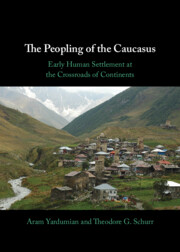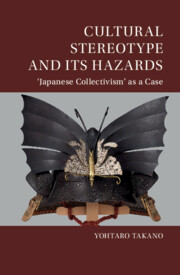296 results
3 - Being in Conflict
-
- Book:
- Political Theology and the Conflicts of Democracy
- Published online:
- 21 March 2025
- Print publication:
- 03 April 2025, pp 144-205
-
- Chapter
- Export citation
Introduction
-
- Book:
- Love and Violence in Sierra Leone
- Published online:
- 28 January 2025
- Print publication:
- 23 January 2025, pp 1-18
-
- Chapter
-
- You have access
- Open access
- HTML
- Export citation

The Peopling of the Caucasus
- Early Human Settlement at the Crossroads of Continents
-
- Published online:
- 21 January 2025
- Print publication:
- 23 January 2025

Modernism, Aesthetics and Anthropology
-
- Published online:
- 09 January 2025
- Print publication:
- 23 January 2025
1 - Hard Binaries and Their Discontents
- from Part I - Theory
-
- Book:
- Contesting Pluralism(s)
- Published online:
- 19 December 2024
- Print publication:
- 02 January 2025, pp 5-29
-
- Chapter
-
- You have access
- HTML
- Export citation
3 - Tribe
-
- Book:
- Ethnos of the Earth
- Published online:
- 12 December 2024
- Print publication:
- 19 December 2024, pp 165-228
-
- Chapter
- Export citation
Advancing an Anthropology of Tax
-
-
- Book:
- Anthropology and Tax
- Published online:
- 12 December 2024
- Print publication:
- 19 December 2024, pp 1-48
-
- Chapter
-
- You have access
- Open access
- HTML
- Export citation

Anthropology and Tax
- Ethnographies of Fiscal Relations
-
- Published online:
- 12 December 2024
- Print publication:
- 19 December 2024
-
- Book
-
- You have access
- Open access
- Export citation
4 - Human Ancestry
-
- Book:
- Evolution for the People
- Published online:
- 21 November 2024
- Print publication:
- 28 November 2024, pp 84-103
-
- Chapter
- Export citation
8 - Social Evolutionism
-
- Book:
- Evolution for the People
- Published online:
- 21 November 2024
- Print publication:
- 28 November 2024, pp 186-216
-
- Chapter
- Export citation

Cultural Stereotype and Its Hazards
- ‘Japanese Collectivism' as a Case
-
- Published online:
- 21 November 2024
- Print publication:
- 28 November 2024
13 - The Anthropology and Sociology of Religion and AI
- from Part III - Religious Studies
-
-
- Book:
- The Cambridge Companion to Religion and Artificial Intelligence
- Published online:
- 20 November 2024
- Print publication:
- 21 November 2024, pp 223-240
-
- Chapter
- Export citation
Chapter 19 - Jacques Roumain, from Indigenism to Nationalism
-
-
- Book:
- A History of Haitian Literature
- Published online:
- 07 November 2024
- Print publication:
- 21 November 2024, pp 343-363
-
- Chapter
- Export citation
Calabresi’s invite: bridging Law & Society and Law & Economics through “situated valuation”
-
- Journal:
- Law & Society Review / Volume 58 / Issue 4 / December 2024
- Published online by Cambridge University Press:
- 18 November 2024, pp. 635-662
- Print publication:
- December 2024
-
- Article
-
- You have access
- HTML
- Export citation
2 - Skull Hunters on the Pampa
- from Part I - Relationality in Field and Expedition Science
-
-
- Book:
- Empire, Colonialism, and the Human Sciences
- Published online:
- 24 October 2024
- Print publication:
- 07 November 2024, pp 31-57
-
- Chapter
-
- You have access
- Open access
- HTML
- Export citation
8 - Investigating Cuauhtémoc’s Bones
- from Part III - Governance, Politics, and Self-Determination
-
-
- Book:
- Empire, Colonialism, and the Human Sciences
- Published online:
- 24 October 2024
- Print publication:
- 07 November 2024, pp 211-236
-
- Chapter
-
- You have access
- Open access
- HTML
- Export citation
5 - Anthropology
- from Part III - Reworking Disciplines
-
- Book:
- Curating the Enlightenment
- Published online:
- 07 December 2024
- Print publication:
- 07 November 2024, pp 135-170
-
- Chapter
- Export citation
7 - The Imperial Logic of American Bioethics
- from Part II - Institutional Encounters, Discipline, and Settler Colonial Logics
-
-
- Book:
- Empire, Colonialism, and the Human Sciences
- Published online:
- 24 October 2024
- Print publication:
- 07 November 2024, pp 176-208
-
- Chapter
-
- You have access
- Open access
- HTML
- Export citation
10 - Bureaucratic Vulnerability
- from Part III - Governance, Politics, and Self-Determination
-
-
- Book:
- Empire, Colonialism, and the Human Sciences
- Published online:
- 24 October 2024
- Print publication:
- 07 November 2024, pp 261-284
-
- Chapter
-
- You have access
- Open access
- HTML
- Export citation
An anthropological critique of psychiatric rating scales
-
- Journal:
- BJPsych Advances , FirstView
- Published online by Cambridge University Press:
- 25 October 2024, pp. 1-9
-
- Article
-
- You have access
- Open access
- HTML
- Export citation


